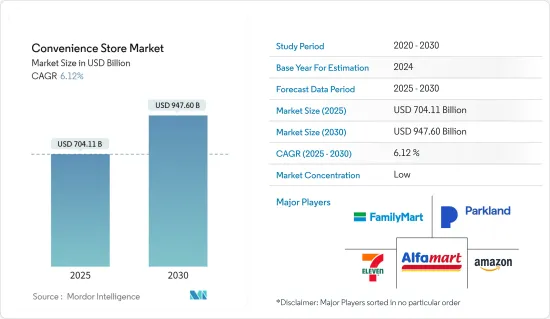
|
市場調査レポート
商品コード
1636105
コンビニエンスストア:市場シェア分析、産業動向・統計、成長予測(2025年~2030年)Convenience Store - Market Share Analysis, Industry Trends & Statistics, Growth Forecasts (2025 - 2030) |
||||||
カスタマイズ可能
適宜更新あり
|
|||||||
| コンビニエンスストア:市場シェア分析、産業動向・統計、成長予測(2025年~2030年) |
|
出版日: 2025年01月05日
発行: Mordor Intelligence
ページ情報: 英文 150 Pages
納期: 2~3営業日
|
全表示
- 概要
- 目次
コンビニエンスストアの市場規模は2025年に7,041億1,000万米ドルと推定され、予測期間(2025-2030年)のCAGRは6.12%で、2030年には9,476億米ドルに達すると予測されます。

世界のコンビニエンスストア業界は、必需品への容易なアクセスや利便性を評価する、時間に追われる顧客の需要に応えて拡大しています。コンビニエンスストアは、ほぼすべての国に遍在し、多様な商品とサービスを提供しています。多くの国で、コンビエンスストアは日常生活に欠かせない存在となっています。コンビニエンスストアでは、スナック、飲料、基本的な食料品、その他の日用品を、大型スーパーマーケットに行かなくても手に入れることができます。コンビニエンスストアは営業時間が長いため、他の店舗が閉まっている夕方や週末でも利用できます。
世界の人口と人口密度は増加の一途をたどっており、既存のコンビニエンスストアは需要の増加に対応するために台頭しています。コンビニエンスストアは、近隣の店舗の商品を簡単に手に入れることができ、24時間営業している店舗もあるため、顧客は必要なときに商品を手に入れることができます。コンビニエンスストアの重要な利点のひとつは、戦略的な立地です。住宅街や交通の要所、商業地区の近くにあることが多く、多様な客層が利用しやすいです。近年、テクノロジーもコンビニエンスストア業界に大きな影響を与えています。セルフレジ、非接触型決済、モバイルアプリなどを導入し、シームレスなショッピング体験を提供している店舗もあります。
コンビニエンスストア市場の動向
コンビニエンスストアの売上増加
コンビニエンスストアの売上高は、消費者の嗜好の変化、商品ラインナップの拡充、テクノロジーの統合、効果的な販促戦略、より広範な社会動向など、さまざまな要因が絡み合って上昇しています。消費者はますます買い物に利便性を求めるようになり、必要な商品を素早く簡単に手に入れることを好むようになっています。営業時間が長く、住宅地に近いコンビニエンスストアは、こうしたニーズによく応えています。さらに、コンビニエンスストアは、スナックや飲食品のような伝統的な商品だけでなく、生鮮食品、調理済み食品、基本的な食料品など、商品の品揃えを拡大してきました。こうした多様化は、より多くの顧客を惹きつけ、売上を伸ばしています。さらに、多くのコンビニエンスストアが、栄養価の高い選択肢を求める需要の高まりに対応し、より健康的な飲食品を提供するようになった。これは、特に健康志向の消費者の間で売上を押し上げるのに役立っています。
アジア太平洋は急成長市場
アジア太平洋地域のコンビニエンスストア市場は、主要な要因に後押しされて大幅な成長を遂げています。急速な都市化により、都市部に住む個人が増加しており、コンビニエンスストアはアクセスしやすく、都市部のライフスタイルに適しています。さらに、コンビニエンスストア・チェーンは、多様な消費者ニーズに対応し、利便性を高めるため、繁華街に小型店舗を構えるなど、革新的な店舗形態を導入しています。
コンビニエンスストアの需要急増の背景には、中国とベトナムにおける中間層の購買力向上があります。特にベトナムの都市部では、ライフスタイルの変化とテンポの速い生活の採用が、コンビニエンスストアの急成長に拍車をかけています。さらに、インフラが整備されるにつれて、店舗の急増が勢いを増し、地元企業間の協力協定によってさらに後押しされ、市場全体の拡大を後押ししています。
コンビニエンスストア業界の概要
コンビニエンスストア・チェーン以外の独立系コンビニエンスストアが世界的に増加しています。コンビニエンスストアは顧客に新鮮な商品を提供しており、その結果、コンビニエンスストアへの来店客数が増加しています。世界最大の大手コンビニエンスストアには、セブン-イレブン、イージー・ジョイ、ファミリーマート、Meiyijia、uSmile、OXXO、Indomaret、Alfamart、Pyaterochka、Magnitなどがあり、市場をリードし、大きな顧客シェアと市場シェアを誇っています。
その他の特典:
- エクセル形式の市場予測(ME)シート
- 3ヶ月間のアナリスト・サポート
目次
第1章 イントロダクション
- 調査の前提条件と市場定義
- 調査範囲
第2章 調査手法
第3章 エグゼクティブサマリー
第4章 市場力学と洞察
- 市場概要
- 市場促進要因
- 市場抑制要因
- 産業バリューチェーン分析
- 業界の魅力度-ポーターのファイブフォース分析
- 買い手の交渉力
- 供給企業の交渉力
- 新規参入業者の脅威
- 代替品の脅威
- 競争企業間の敵対関係
- 市場における技術革新の洞察
- COVID-19の市場への影響
第5章 市場セグメンテーション
- 製品タイプ別
- 定番製品
- 衝動買い製品
- 緊急用製品
- 店舗タイプ別
- キヨスク
- ミニコンビニエンスストア
- 限定セレクションコンビニエンスストア
- 従来型コンビニエンスストア
- 拡大コンビニエンスストア
- ハイパーコンビニエンスストア
- 地域別
- 北米
- ラテンアメリカ
- 欧州
- 中東・アフリカ
- アジア太平洋
第6章 競合情勢
- 市場集中度の概要
- 企業プロファイル
- 7-Eleven
- Easy-Joy
- Family Mart
- Meiyijia
- uSmile
- OXXO
- Indomaret
- Alfamart
- Pyaterochka
- Magnit
第7章 市場機会と今後の動向
第8章 免責事項と出版社について
The Convenience Store Market size is estimated at USD 704.11 billion in 2025, and is expected to reach USD 947.60 billion by 2030, at a CAGR of 6.12% during the forecast period (2025-2030).

The global convenience store industry is expanding, meeting the demands of time-pressed customers who appreciate easy access to necessities and convenience. Convenience stores are ubiquitous across nearly all nations, providing diverse products and services. In many countries, convenience stores are an integral part of daily life. They allow people to grab snacks, beverages, basic groceries, and other daily necessities without visiting larger supermarkets. The extended operating hours of convenience stores make them accessible even during evenings and weekends when other stores may be closed.
The global population and population density are continuously rising; existing retail convenience stores are rising to meet the increasing demand. A convenience store provides easy access to products from nearby stores, and with some stores opening 24 hours a day, customers can access their products when needed. One of the critical advantages of convenience stores is their strategic locations. They are often found in residential areas, near transportation hubs, or in commercial districts, facilitating their easy accessibility to a diverse clientele. In recent years, technology has also had a big impact on the convenience store industry. Some stores have implemented self-checkout systems, contactless payment options, and mobile apps for seamless shopping experiences.
Convenience Store Market Trends
Rise in Sales of Convenience Store
The rise in sales at convenience stores can be attributed to a combination of factors, including changing consumer preferences, expanded product offerings, technology integration, effective promotional strategies, and broader societal trends. Consumers are increasingly seeking convenience in their shopping experience, preferring quick and easy access to essential items. Convenience stores, with their extended hours and proximity to residential areas, cater well to this need. Additionally, convenience stores have expanded their product offerings beyond traditional items like snacks and beverages to include fresh food, ready-to-eat meals, and basic groceries. This diversification has attracted more customers and increased sales. Moreover, many convenience stores are now offering healthier food and beverage options, catering to the growing demand for nutritious choices. This has helped boost sales, especially among health-conscious consumers
Asia Pacific is the Fastest Growing Market
The convenience store market in the Asia-Pacific region is undergoing substantial growth, fueled by key factors. Rapid urbanization is driving more individuals to live in cities, where convenience stores are easily accessible and tailored to urban lifestyles. Additionally, convenience store chains are introducing innovative store formats, like small-format stores in busy areas, to meet diverse consumer needs and enhance convenience.
The surge in convenience store demand is attributed to the rising purchasing power of the middle class in China and Vietnam. Lifestyle shifts and the adoption of fast-paced living have particularly fueled the rapid growth of convenience stores in urban areas of Vietnam. Additionally, as infrastructure improves, the proliferation of outlets gains momentum, further boosted by collaborative agreements among local businesses, driving overall market expansion.
Convenience Store Industry Overview
With the amount of capital required, a large number of independent convenience stores are emerging globally, other than convenience store chains. Convenience stores are providing customers with fresh products, which is resulting in an increase in foot traffic towards these stores. Among the largest and leading convenience stores globally, there are 7-Eleven, Easy Joy, Family Mart, Meiyijia, uSmile, OXXO, Indomaret, Alfamart, Pyaterochka, and Magnit, with their leadership in the market and large customer and market shares.
Additional Benefits:
- The market estimate (ME) sheet in Excel format
- 3 months of analyst support
TABLE OF CONTENTS
1 INTRODUCTION
- 1.1 Study Assumptions and Market Definition
- 1.2 Scope of the Study
2 RESEARCH METHODOLOGY
3 EXECUTIVE SUMMARY
4 MARKET DYNAMICS AND INSIGHTS
- 4.1 Market Overview
- 4.2 Market Drivers
- 4.3 Market Restraints
- 4.4 Industry Value Chain Analysis
- 4.5 Industry Attractiveness - Porter's Five Forces Analysis
- 4.5.1 Bargaining Power of Buyers
- 4.5.2 Bargaining Power of Suppliers
- 4.5.3 Threat of New Entrants
- 4.5.4 Threat of Substitutes
- 4.5.5 Intensity of Competitive Rivalry
- 4.6 Insights of Technology Innovations in the Market
- 4.7 Impact of COVID-19 on the Market
5 MARKET SEGMENTATION
- 5.1 By Product types
- 5.1.1 Staple Products
- 5.1.2 Impulse Products
- 5.1.3 Emergency Products
- 5.2 By Store Types
- 5.2.1 Kiosks
- 5.2.2 Mini Convenience Stores
- 5.2.3 Limited Selection Convenience Stores
- 5.2.4 Traditional Convenience Stores
- 5.2.5 Expanded Convenience Stores
- 5.2.6 Hyper Convenience Stores
- 5.3 By Region
- 5.3.1 North America
- 5.3.2 Latin America
- 5.3.3 Europe
- 5.3.4 Middle East and Africa
- 5.3.5 Asia-Pacific
6 COMPETITIVE LANDSCAPE
- 6.1 Market Concentration Overview
- 6.2 Company Profiles
- 6.2.1 7-Eleven
- 6.2.2 Easy-Joy
- 6.2.3 Family Mart
- 6.2.4 Meiyijia
- 6.2.5 uSmile
- 6.2.6 OXXO
- 6.2.7 Indomaret
- 6.2.8 Alfamart
- 6.2.9 Pyaterochka
- 6.2.10 Magnit

